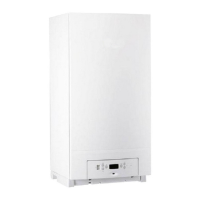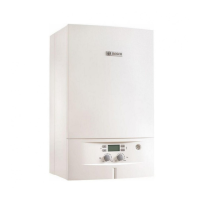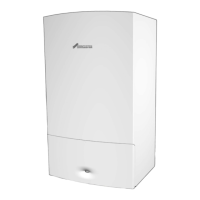Regulations
11
Condens 7000 FP – 6721846699 (2022/12)
3.6 Quality of the heating water
As pure water cannot be used for heat transfer, water quality is
important. Poor water quality can damage heating systems due to scale
formation and corrosion.
Water quality is an essential factor for increased efficiency, functional
reliability, long service life and for maintaining the constant operational
condition of a heating system.
Observe the water quality requirements contained in the "Water
Quality Operator's Log".
Warranty claims for the boilers will only be considered provided the
water quality requirements have been met and the operator’s log has
been maintained.
3.7 Pipework quality
NOTICE
Boiler damage through corrosion.
Never operate this boiler as a gravity-fed or as open vented heating
system unless working in combination with a hydraulic system
separator with a heat exchanger.
When using plastic pipes in the heating system, for example in
underfloor heating systems, ensure these are impermeable to oxygen in
accordance with DIN 4726/4729. If the plastic pipes do not comply with
these standards, they must be separated from the rest of the system
using a heat exchanger.
3.8 Combustion air quality
To avoid corrosion, keep the supply of combustion air free of
corrosive substances (e.g. halogenated hydrocarbons that contain
chlorine or fluorine compounds).
Keep the combustion air supply free of dust or use the “air filter”
accessory set .
3.9 Combustion air/flue gas connection/air vents
The installation room must be equipped with the required combustion
air openings or ventilation apertures leading to the outside.
The conditions of installation rooms and the setting up of gas appliances
must comply with country-specific regulations.
WARNING
Danger to life due to poisoning!
Risk of poisoning due to escaping flue gases when the air supply is
inadequate.
Make sure that a supply of air is available in every operating mode
through corresponding openings to the open air.
Inform the user about the need for the openings.
The following applies for open-flue mode:
Provide a combustion air opening that complies with the minimum
size specified in table 4
1)
.
Table 4 Combustion air openings during open flue operation
Never place objects in front of these vents.
Ensure that combustion air vents are unobstructed at all times.
The following applies for room sealed operation:
The boiler must be connected to a flue system.
Observe country-specific and local regulations.
Observe attached documentation "Information on flue gas routing".
In order to provide ventilation, the installation room must have a
ventilation aperture leading to the outside of at least 150 cm
2
, or
ventilation vents of at least 2 × 75 cm
2
, or pipes to the open air with
equivalent flow cross-sections.
1)
At rated outputs above 100 kW, a top and bottom vent of 150 cm
2
respectively is required. The ventilation apertures must be enlarged by
1cm
2
for each kW over 100 kW.
Never place objects in front of these vents.
The air vents must always be unobstructed.
Calculate dimensions of the air supply pipe in accordance with the
applicable regulations.
Provide a combustion air opening that complies with the minimum
size specified in table 5
1)
.
Table 5 Combustion air openings during balanced flue operation
For additional information on the combustion air/flue gas connection,
see chapter 5.6, page 19.
3.10 Frost protection
Observe technical documentation of the installed control unit for
frost protection settings.
1) In addition to this, country-specific and local regulations must be observed.
Combustion air vents
Boiler size [kW] Area per opening [cm
2
] Number of openings [n]
350 400 2
400 450 2
500 550 2
Combustion air vents
Boiler size [kW] Area per opening [cm
2
] Number of openings [n]
350 400 2
400 450 2
500 550 2

